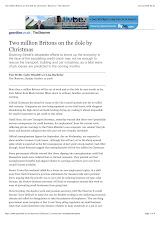Tampering with the gifts of nature can only lead to newer catastrophes, Gordon! So don't do it...
By©Muhammad Haque
1215 Hrs GMT
LOndon
Sunday 18 May 2008
Gordon Brown has lost the much-vaunted image as the ‘m,an who brought prudence’ into the management of the UK economy. This loss is largely of his own making. Had he been genuinely prudent, he would not have made that folly. It will take the best part of the rest of his ‘tenure’ at the official address of the UK Prime Minster, to restore that position.
And unless Brown is very careful, he will lose the other, substantially floated claim as well. The claim that he is, at the end of the day and all the rest of it, and as being peddled in his defence by some at least of the mainstream media pluggers, a ‘decent man’.
It cannot be decent to embark on a programme of twisting the very foundation and the core of human kind. And of animal kind.
And Brown is just about able to pull back from the new folly that he is boastfully heading for.
He must not go ahead with the assault on nature. Not on human beings. Not on animal beings.
There is clear evidence that tampering with nature is not good. If there are resources to engage in research, in learning, in study then those should be devoted to the pursuit of learning. Leaving nature alone. When Gordon Brown has been appearing on far too many 'sermon'-like platforms and appearing to make claims to be motivated by ethics and morality it then cannot be right for the same person to collude with the opposite programme.
The man who could, 'just like that', pull off a trick of finding nearly £3 Billion to ensure that his [so far] short regime did not become historically short-lived and get submerged, derailed at the critical Crew junction of his contradictions under the weight of evidence of his paraded incompetence and imprudence, cannot be allowed, ethically, morally, economically and financially, to claim that there is not enough financial capacity 'in Government ' [the boastful way he says 'in Government' is plainly worrying...] to organise genuine and long term research into ways of finding any solutions without committing this grotesque outrage against the autonomy maintained by nature.
The only clue to Brown’s appearance of ‘being knowledgeable’ in favour of the violations he plots against the natural autonomies should be sought in the business agenda of the globalising Big Business Neo Con Corporations...
The arguments against the tendency that Gordon Brown and his co-travelling violators of nature are now displaying, have been going on for a while. We here produce one small example from 2000. It is from one of thousands of sources, active in the North American hemisphere:
Khoodeelaar! offers ANOTHER timely piece of timeless advice to the career-driven Gordon Brown: Don't do it, Gordon. Don't defy nature.....
"
Beyond Bad Science and Big Business
Lecture for ‘Big Money Bad Science’ Teach-in on globalisation and genetic engineering, Vogue Theatre, Vancouver, November 10, 2000. Dr. Mae-Wan Ho
Abstract
The mechanistic mindset of western science is all of a piece with the neo-liberal economic theory promoting globalisation - the removal of all international barriers to trade, investment and finance - that has enabled corporations to ruthlessly exploit human beings and destroy our planet in their quest for maximum profit. This paradigm has failed us in life as it has within science, but is still perpetrated by the academia and the political mainstream, if only because it serves so well to promote gene biotechnology and to make even unethical uses seem compelling.
GM crops destroy livelihood and self-sufficiency, and are strenuously opposed by family farmers everywhere. There is compelling evidence that genetic modification is inherently unsafe, as are many of the GM products. While the benefits of GM crops remain illusory, the success and benefits of ecological, natural farming systems are well documented. It is time to turn the tide on bad science and big business, to reclaim the good life in every sense for everyone.
Britain might be mistaken for a Third World country, says a newspaper headline: chaos on the rail network and protests over fuel price increase in the midst of the worst storms and floods in decades, and a CJD epidemic that may claim up to tens of thousands of lives.
The public enquiry report, published at the end of October, blames persistent government denials over the link between CJD and BSE beef based on the ‘best scientific advice’ given by the Southwood Committee in 1989, which concluded "it was most unlikely that BSE will have any implications for human health". The ‘best scientific advice’ is saying the same about genetic engineering. The scientific establishment has failed, again and again, to acknowledge that science is by its nature incomplete and uncertain and to insist on the precautionary approach. The precautionary approach might also have averted global warming, had it been adopted ten, twenty years earlier. It is high time that the precautionary approach is applied now in gene biotechnology.
If climate change and the CJD fiasco can teach us anything, it is that science is too important to be left to the politicians or to a scientific establishment increasingly in bed with big business. Our academic institutions have given up all pretence of being citadels of higher learning and disinterested enquiry into the nature of things; least of all, of being guardians of the public good. The corporatization of science is the greatest threat to our survival, and it works in subtler ways than generally recognized.
Western science dominates the world through its technologies, many of which become instruments of destruction and oppression in the hands of corporate business. More significant, however, is the mechanistic mindset of the science, through which the world is perceived and shaped. It presents nature as isolated atoms at every level, jostling and competing against one another in the Darwinian struggle for survival of the fittest. Organisms are mistaken for machines, and there is no limit to how they can be manipulated for profit, especially by changing their genes. Genes and genetically modified organisms (GMOs) have become the latest, hottest commodities.
The mechanistic mindset is all of a piece with the neo-liberal economic theory promoting globalization - the removal of all international barriers to trade, investment and finance - that has enabled corporations to ruthlessly exploit human beings and destroy our planet in their quest for maximum profit. That was why 50 000 took to the streets of Seattle to close down the World Trade Organisation last November; and a further 20 000 turned up to demonstrate against the World Bank in Prague this September. And it will go on, until peoples’ aspiration for a safe, just, equitable, sustainable and compassionate world is heeded.
The mechanistic paradigm has failed us in life. It has also failed within science. Contemporary western science, across the disciplines, has been rediscovering how nature is organic, dynamic and interconnected. There are no linear causal chains linking genes to the characteristics of organisms, let alone the human condition. Genes function in complex entangled networks, constantly responding to feedback from the internal and external environment. Genetic engineering grew out of laboratory techniques for modifying the genetic material of organisms discovered some 25 years ago. These same techniques enabled geneticists to study the genetic material in ways that were not possible before. The findings have turned genetics upside down.
By the 1980s, geneticists have coined the phrase, "the fluid genome" to describe the dynamic state of the genetic material in all organisms, which is subject to both small and large changes in the course of development and in response to feedback from the environment. The new genetics is radically holistic and ecological, as is life itself. But the discredited paradigm is still perpetrated by our academia and the political mainstream, if only because it serves so well to promote gene biotechnology, and to make even unethical uses seem compelling.
The human genome project to map the genetic material of our species has been hyped a great deal, but the only concrete offers thus far are patented gene tests, some 740 already in the market. In cases where such tests can help to diagnose and treat patients, exorbitant licence fees have prevented their use. On the other hand, healthy people testing positive are denied employment and health insurance. Among the human genes and cell lines patented and sold by corporations are those stolen from indigenous tribes under the pretext of providing medical care, and even coercion is used.
Prenatal and pre-implantation diagnoses are eliminating human foetuses and embryos carrying genes said to pre-dispose them to cancer as adults. Jim Watson, co-winner of the Nobel Prize for the structure of DNA, the genetic material, suggested that parents might want to eliminate the unborn carrying homosexuality genes. There are no such genes, by the way.
The overwhelming causes of ill health are environmental and social. The World Health Organisation has long concluded that at least 80 percent of all cancer is attributable to environmental influences. Hundreds of actual and potential carcinogens have been identified among the 70 000 industrial chemicals that pollute our air, water and soil. Rising epidemics of childhood cancers are linked to mutations caused by radioactive wastes seeping from processing plants, or dumped into the sea and washed up on our beaches. But the cancer research establishment is doing little for cancer prevention except identifying putative genes predisposing people to cancer.
The focus on genes is misplaced. It is diverting attention and resources away from the real causes of ill health, allowing the chemical industry to continue to pollute our life support system with impunity, and to profit from the lucrative health market created by the rising tide of ill health. A headline in the financial pages of The Guardian (Wednesday August 2, 2000) says it all: "Gene hunters say patients are a bankable asset". Worse yet, the ‘genetic mantle’ placed on diseases and other human conditions end up blaming the victims, fueling the re-emergence of genetic discrimination and eugenics that have blighted the history of the last century.
A prominent band of scientists and ‘bioethicists’ are advocating human germline gene therapy, which amounts to making genetically modified human beings. They see the creation of a gene-rich class of human beings to be inevitable due to the free reign of the global marketplace. The rich will pay to genetically enhance their offspring, in the same way that they will pay for expensive private education. Consequently, there will be a genetic underclass - children of the poor - that will eventually become a separate, inferior species. Social inequity is thereby translated into genetic inequity and vice versa.
Human embryos are cultured in the laboratory to provide cells and tissues for transplants. International trafficking of human organs is already rife, and eggs and embryos will be added to the list. In the Indian Seed Tribunal in September, three farmers in the same family in told the Tribunal how each had to sell a kidney when their crops failed from the bad seeds they were sold. They were the responsible ones, other farmers committed suicide instead. In future, the women may well be forced into selling their eggs and embryos.
Two years ago, the first ‘human’ clone was created, by transferring the genetic material of a human cell into a cow's egg. In October this year, researchers from an Australian and a US company made another by transferring human genetic material into the egg of a pig. Mercifully, the experiments were destroyed at 14 days, which is the current legal limit; or we would have been faced with Frankenstein. At least the original Dr. Frankenstein did not do it for money. And that is the bottom line. In deciding whether any application is ethical or beneficial, ask whether it would be done if there were no money to be made. And who but the rich can benefit when all the genes, cell lines and reproductive processes are patented for commercial exploitation?
Gene biotechnology is not just about GM food or GM human beings. It is a commitment to an existential nightmare, a descent into a self-made hell on earth. Mary Shelley´s brilliant novel was not only a parable of the arrogant scientist playing God, it is also about mechanistic science out of control, today, in the service of the corporate empire.
In China, where my family originates, ‘rice’ pronounced ‘faan’ means livelihood, it means contentment and self-sufficiency. In Thailand, rice is life, and the Karen hill tribes are so intimately connected to rice that the ‘rice spirit’ is brought back to the people and the land in a rice ceremony every year. Tens of thousands of rice varieties still exist in Thailand, which have been collected, created and propagated by farmers in the course of thousands, if not tens of thousands of years. That, despite the fact that a US scientist, Dr. Love, absconded with 120 000 varieties collected for the Thai gene bank in the 1950s.
Thai rice varieties come in endless shades of gold, red and black, each with a distinctive fragrance, serving different purposes and occasions, to enhance life as much as to provide nutrition. Each variety is valued and loved for its own sake, more than a connoisseur might appreciate varieties of tea, coffee or wine. I was given a bag of red rice to take home to London, and have savoured every mouthful since. Seeds are freely given and exchanged as gifts among farmers in Thailand, as they are all over Asia, Latin America and Africa.
To people whose lives are so inextricably interwoven with their indigenous plant varieties, what else can GM crops be but an abomination? And why should the rest of us not recover to some extent this aesthetic and spiritual connection to our food?
There is little doubt that GM crops will further destroy livelihood and self-sufficiency through corporate patents on seeds that farmers cannot resow or exchange, and through GM ‘terminator’ seeds that are rendered sterile, breaking the very cycle of renewal and regeneration that is the essence of life. There are 152 patents on rice, some 70 of them associated with the GM ‘golden rice’ that Astra Zeneca is supposed to be offering free to the Third World as a cure for Vitamin A deficiency.
Farmers all over South East Asia are incensed about the introduction of GMOs and the accompanying corporate propaganda and intimidation. In September, thousands of Thai citizens plus representatives from Cambodia, India, Malaysia and the Philippines took part in a long protest march. They issued a joint declaration rejecting all GMOs and patenting of seeds and plant varieties, and demanding government support for sustainable, natural farming systems.
GM is furthermore an untried, inadequately researched technology. There is no evidence that GM crops are safe, of the kind that could stand up in a court of law or to scientific scrutiny, despite what our regulators and their chosen scientists are saying.
The UK Government tried to place Aventis’ Chardon LL GM corn on the National List, but overwhelming objection from the public forced a public hearing which is still going on. Aventis is also behind the recent massive recall of taco shells and other maize products contaminated with the ‘Starlink’ GM variety that has not been approved for human consumption because it showed all the signs of being allergenic. As for Chardon LL, Aventis’ unpublished report submitted to the hearing showed that there were twice as many deaths in chickens fed the GM corn compared to those fed non GM corn. And on the basis of that, our Government had approved it for use as animal feed.
There is less than a handful of published papers on GM food safety from industry, and these are no better. The two papers from Monsanto on Roundup Ready GM soya showed that it increased milk fat in cows and decreased weight gains in male rats, and has an unexpected 26.7% increase in a-antitrypsin, a major allergen and growth inhibitor. Monsanto failed to make available even more damning data indicating that the GM soya had 100% increase in soya lectin, another allergen, which was also unexpected.
The evidence of hazards, much of it in the scientific literature, is stronger than ever before. That is why some 370 scientists from more than 40 countries are calling for a moratorium, as well as a ban on patents of organisms and living processes and support for sustainable, organic agriculture (see www.i-sis.org.uk).
The hazards are inherent to the uncontrollable, unpredictable nature of the genetic modification process (see Boxes 1 and 2).
Box 1
GM is inherently hazardous
GM involves making artificial genes and combinations of genes that are transferred into cells and embryos to create GMOs, none of which may ever have existed in billions of years of evolution.
GM genetic material are typically from dangerous bacteria, viruses and other genetic parasites that cause diseases and include antibiotic resistance genes that make infectious diseases untreatable. The gene products encoded by the genes may be harmful, as they have never been part of our food chain, and are also new to the ecosystem.
GM constructs are designed to cross species barriers and to invade genomes. But the genetic engineer cannot control where and in what form the GM constructs end up in the genome. Unexpected toxins and allergens may result.
GM constructs are unstable, as are GM lines. GM constructs are often scrambled when inserted in the genome. In later generations of the GMO created, the GM constructs may get scrambled further, become inactive or lost altogether. This seriously compromises agronomic performance as well as safety, because the GM line will change further in unexpected ways, and the lost genes may jump into unrelated species.
Dangerous GM genes and constructs can spread, not just by cross pollination to related species, but by horizontal transfer to unrelated species, spreading antibiotic resistance genes, creating new viruses and bacterial pathogens, and triggering cancer in animals.
The biotech industry and their supporters claim we need GM crops to feed a growing world population. But UN studies show that world population growth has been slowing down since the 1960s. The prediction in 1998 was that total world population will peak at 7.7 billion in 2040, then go into long term decline to 3.6 billion by 2150, less than two-third of today’s number. The FAO report on Agriculture released earlier this year, similarly concludes that existing technologies, not counting GM, will produce enough and more than enough food to meet population growth for the foreseeable future. The real problem is distribution, as generally acknowledged. People are starving in the midst of plenty.
Finally, there is plenty of evidence that low input, ecological farming methods using crops and knowledge adapted to local conditions have been increasing yields two, three-fold or more in Latin America, Africa and Asia since the 1980s, providing social, environmental and health benefits besides. There are compelling reasons for farmers to grow and sell locally crops adapted to local conditions, rather than national or international varieties for export. Export industrial agriculture is responsible for a great proportion of the fossil fuel consumption that contributes to climate change. There is also incalculable health bonus to be gained by all in phasing out agro-chemicals already linked to cancers and many other illnesses.
In short, now is the time for all of us to join forces to turn the tide on bad science and big business, to reclaim the good life in every sense for everyone.
Box 2
Evidence that GM and GMOs are unsafe
Bt-toxins, isolated from a soil bacterium, Bacillus thuringiensis, and incorporated into a wide range of GM crops, are harmful to beneficial and endangered species, such as lacewings and the monarch butterfly.
Several Bt toxins are allergens or suspected allergens, including the Cry9C in Aventis’ Starlink GM corn, which is responsible for the recent massive recall of contaminated taco shells and other corn products in the United States and elsewhere.
Random insertion of GM constructs result in monstrous abnormalities in animals such as pigs and fish. No one has checked for toxins and allergens.
In plants, unexpected toxins and allergens have arisen, as in Monsanto’s GM soya: 26.7% increase in allergen and growth inhibitor, a-antitrypsin, and 100% increase in soya lectin, another allergen.
In 1989, a genetically modified batch of tryptophan killed 37 and made 1500 seriously ill, many to this day.
The instability of GM constructs lead to inconsistent performance in the field, yield drag, and other failures which have frequently turned up in GM crops.
Herbicide tolerant GM crops created weeds and superweeds. A canola resistant to three different herbicides made by different companies, was found in Alberta, Canada.
GM genes in GM pollen have transferred to bacteria and yeasts in the gut of baby bees.
UK government scientists provided indirect evidence that antibiotic resistance genes from GM pollen and dust can transfer to bacteria inhabiting the human mouth and respiratory tract.
GM genes from GM plants have been found to transfer to soil bacteria in laboratory experiments and in field monitoring.
GM corn DNA has been found transferred to chicken.
‘Gene therapy’ experiments show that animal cells, including human cells, can readily take up GM constructs, and incorporate them into the genome. These GM constructs are similar to those used to make GM plants and animals and pose the same risks.
New viruses have arisen in GM plants engineered with viral genes.
GM constructs may recombine with, and wake up dormant viruses that have now been found in all genomes. Reactivation of dormant viruses by GM constructs in cultured cells is a major problem in packaging gene therapy vectors.
Random insertion of GM constructs into animal genomes may lead to cancer. This also occurs when GM constructs are put into cultured cells.
printer friendly version
Recent Publications
Food Futures Now: *Organic *Sustainable *Fossil Fuel Free How organic agriculture and localised food (and energy) systems can potentially compensate for all greenhouse gas emissions due to human activities and free us from fossil fuels
Buy Now|More info
The only radical science magazine on earth
Science in Society 37 OUT NOW! Order your copy from our online store.
Genetic Engineering: Dream or Nightmare? New Reprint with Extended Introduction and Update by the Author
Buy Now|More info
GM Science Exposed. A comprehensive dossier containing more than 160 fully referenced articles from the Science in Society archives.
Buy Now|More info
GMO Free: Exposing the Hazards of Biotechnology to Ensure the Integrity of our Food Supply
Buy Now|More info
Join the I-SIS mailing list; enter your email address html asci
I-SIS is a not-for-profit organisation, depending on donations, membership fees, subscriptions, and merchandise sales to continue its work. Find out more about membership here
"
Subscribe to:
Post Comments (Atom)




























![Khoodeelaar! constitutional law campaign against the 'Crossrail Bill' [a Bill in UK Parliament]](http://2.bp.blogspot.com/_pSmwp9aFK8U/SGqe5VQwLHI/AAAAAAAABfc/MEjjMWby2dc/S226/Khoodeelaar!+try+this+logo.gif)


























![London [Rupert Murdoched] Times, Wed. 7 May 2008](https://blogger.googleusercontent.com/img/b/R29vZ2xl/AVvXsEitiFRN6uO_MOdYMby0s7ow2zcBaewOKfl3k4QdCPcahu1IKXx6sl7Gs4aO9VrAhN8gQJvYb1a2JnODsTUsMks_LtoZVuqc64whMkMitNKVz1bijPST853uNwRNG8x2PVFl1kqRez8M3b-j/s226/1676149.jpg)






































































No comments:
Post a Comment